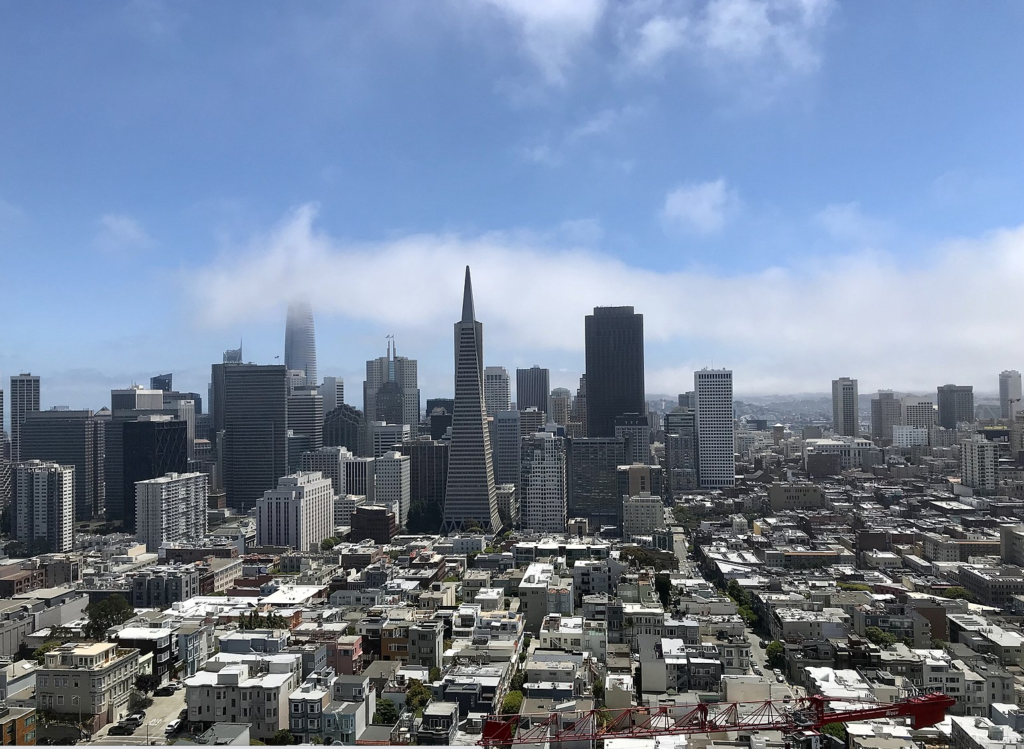Two times during the 1980s, Mayor Dianne Feinstein personally lectured me about how it was wrong to limit San Francisco’s downtown office development, as our community advocacy coalition, San Franciscans For Reasonable Growth, then proposed due to the resulting impacts on transportation/transit systems, the city’s unmet housing demands, and the loss of San Francisco’s unique spirit and character from ubiquitous displacement of low-rent spaces.
“Now, John,” she would begin, like a schoolteacher reproving a bad boy, “you must understand. Our Downtown is the goose that lays the Golden Eggs!”

Dianne meant the Financial District, and its highrise office towers filled with corporate headquarters, lawyers, and brokers, the long-time 19th/20th Century San Francisco companies that were the foundation of the city’s post-industrial economy: Bank of America, Chevron, Bechtel, Crocker Bank, Wells Fargo, Transamerica, PG&E, Southern Pacific Railroad, the Pacific Stock Exchange, and others.
Now they are all gone. Some were gobbled up in the merger-mania of the 1980s, while others moved to the suburbs.
Downtown-centered corporate growth and real estate development had been the core economic strategy of San Francisco’s civic elite ever since the end of World War II, requiring new mass transit capacity costing billions of dollars to move hundreds of thousands of commuters in and out of Downtown every day – BART, Muni/Metro, and someday a Transbay Caltrain terminal. I was supposed to understand, of course, that the trickle-down economic benefits of Downtown would keep San Francisco a prosperous and wonderful place to live for all.
But instead, the great new wealth creation that Downtown represented went to the benefit of those at the top of the city economy, not the rest of the city and its people.
But SFRG finally won “Prop M’s” office construction limits at the ballot box in 1986, and not much changed. There were no business taxes or development exactions in those days to channel any of that Downtown wealth creation to the needs of the city’s people and communities. Then over the following decades a series of progressive measures won new Downtown revenues for housing, education, Muni, and more. Yes, we even managed to steal a few of those Golden Eggs.
But then the civic elite got very lucky. Thanks to the city’s still-alive character and spirit, a first wave of tech entrepreneurs flocked to San Francisco in the 1990s to escape the suburban blandness of nearby Silicon Valley. They launched a new era of tech media/cloud start-ups here.
This first San Francisco boomlet imploded in 2000 due to crashing speculative stocks. But that nascent SF tech industry survived through the Great Recession that followed, and then took off spectacularly as the multifaceted digital internet revolution spread worldwide, igniting a Second Great San Francisco Gold Rush during the following 2010/20 decade.
Suddenly Downtown office towers had new tech tenants to replace the bygone old-time corporates of yore, and more! New towers rose dramatically, like the Salesforce Tower in an expanding Financial District, and Twitter and others filled a revitalized Mid-Market district too. But it all still depended on a huge daily commuter workforce for all these new companies, just like the decades before.
And as new Tech wealth flooded into the city, along with thousands of opportunity seekers, runaway inflation hit the city housing market, resulting in widespread displacement of longtime residents in central city neighborhoods. And suddenly the personality of San Francisco changed—to “get rich quick”— but the city’s former spirit from times before became priced out, and faded.
Then! This time it was not a Great Earthquake and Fire that suddenly brought this Second SF Gold Rush to an overnight end. No, it was … a plague! The Global Covid Pandemic.
So in the course of only a few years, the whole world discovered there is no compelling need for all office work to be done in the same physical location, like the Financial District. It can largely be done instead in The Cloud, even from far away. Which means no longer is there a reason for hundreds of thousands of office workers to commute back and forth to Downtown San Francisco—many/most can “work from home” instead.
The impacts of this Downtown workplace revolution have hit far and wide. Billion-dollar Downtown office towers are now worth only half of what they were before, while dozens of the small shops there that depended on these now-missing commuter costumers have closed. Much of San Francisco’s Downtown today looks half-abandoned. Now at last we hear a cry of the civic elite, something must be done!
Stepping back to the perspective from 50-60 years ago, the fundamental idea of a commuter-focused Downtown of corporate headquarters as the foundation for the city’s economy, it’s Golden Goose, was always misbegotten (sorry, Mayor Feinstein). It was never about the city we really are or could be, and keeping that city and its communities alive and thriving. And the Golden Eggs it produced were never enough to really trickle down, and were never shared with all the people of our city.
Bang the drums slowly, play the pipe lowly. The Golden Goose of San Francisco is dead. An era has come to an end.




